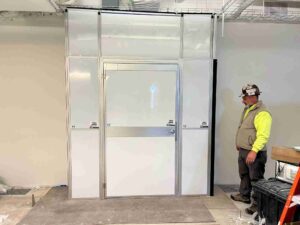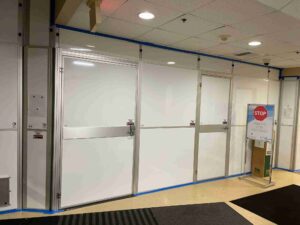A Contractor’s Guide to Drywall vs. Temporary Wall Systems
Temporary Wall Systems vs. Drywall: The Lowdown
In the construction industry, drywall has long been used as a means of containing renovation projects. It’s one of the most common and traditional materials used for containment. But does that mean it’s the optimal solution? What are the alternatives to drywall?
Temporary Wall Systems: The Best Drywall Alternative
Contractors looking to save time on job sites have started researching drywall alternatives. Using drywall to build containment walls takes materials, time, and effort. One of the best alternatives to drywall is a rented modular wall system like Temporary Wall Systems (TWS) because it solves many of the material and time issues.
But if you haven’t heard of TWS or have not yet tried it, we’re here to give you some helpful tips. We’ve created this guide to help you understand the budget considerations, installation time, effectiveness, and overall experience for customers looking for a drywall alternative.
Time is Money: Save with a Drywall Alternative
Let’s consider the total scope of using drywall and the factors that go into the costs. To use drywall on a job site, multiple steps have a monetary cost in labor, time, and materials. The average price of a drywall panel can range from $0.40 per sq. ft. to $3.00 per sq. ft., depending on the client’s needs.
Below is a list of the costs of using drywall:
- The process of purchasing drywall, studs, fasteners, tape, and mud.
- The labor cost to build the drywall containment.
- The labor cost to remove the drywall containment.
- The material disposal cost after the project is done.
- Repeat for the next renovation.
Temporary Wall Systems is an excellent drywall alternative because it takes away most of those steps. Because the walls are rented, delivered, installed, and removed, there are no labor or training costs for contractors. Also, because the walls are prebuilt and modular, Temporary Wall Systems can construct containment in hours, whereas drywall can take days.
Our modular containment system is also reusable, so there’s no waste at the end of the project. These factors make our rentable Temporary Wall Systems containment a more budget-friendly and environmentally responsible option than drywall.
Containment Effectiveness
The most crucial factor to consider when choosing between Temporary Wall Systems and drywall is its containment level. Drywall and plastic sheeting are mainly focused on keeping people out of the work area and protecting construction tools rather than containing dust and debris. Temporary Wall Systems panels provide airtight containment, ensuring no airborne particles can escape the construction zone.
Get Rid of Drywall Dust
This is extremely important when renovating inside hospitals and healthcare facilities, as there’s the risk of spreading airborne particles that could cause infection and harm to patients. As a drywall alternative, TWS does not create dust when installing or removing the walls.
The dust from installing and dismantling a drywall containment can pose a severe health risk, especially in hospitals, labs, data centers, and other particulate-sensitive sites. Drywall dust can be as small as 1 micron, which can take up to 12 hours to settle. Our rentable Temporary Wall Systems containment systems also meet ICRA IV requirements, meaning they are the perfect solution in hospitals and nearly any other renovation setting.
Keep the Business Open: TWS vs. Drywall
In addition to protecting staff, patients, customers, and visitors, it’s also important to consider how day-to-day operations will continue during renovations and how it will affect the customers. As we mentioned, drywall can be a lengthy process both to install and remove, making for a messy and noisy environment.
Also, drywall may not effectively reduce sound, causing disruptions during construction and hurting the customer experience. Conversely, our Temporary Wall Systems wall containment has a professional, real-wall appearance and sound attenuating qualities. As a contractor, your customer will thank you for using a drywall alternative that ensures the businesses can continue normal operations during renovations.
Sustainable Drywall Alternatives
Drywall, while commonly used in construction, is not the most sustainable material due to its high energy consumption during production and its non-biodegradable nature. Here are some sustainable alternatives to traditional drywall:
- Modular Wall Systems: Modular walls like TWS are one of the most sustainable drywall alternatives because they can be reused multiple times and the panels can fit a wide variety of heights.
- Recycled Drywall: Some manufacturers produce drywall made from recycled materials, such as recycled gypsum or recycled paper. These products reduce the environmental impact associated with traditional drywall production by reusing materials that would otherwise end up in landfills.
- Wood Fiberboard: Wood fiberboard, also known as fiberboard or particle board, is made from compressed wood fibers. It is lightweight, easy to work with, and can be used as a sustainable alternative to drywall for interior walls and ceilings.
- Cork Panels: Cork is a renewable material harvested from the bark of cork oak trees. Cork panels can be used as wall coverings or insulation material, providing both thermal and acoustic insulation properties.
- Bamboo Panels: Bamboo is a fast-growing and renewable resource that can be used to make panels like traditional drywall. Bamboo panels are lightweight, durable, and have a low environmental impact compared to traditional materials.
Contact Temporary Wall Systems
This guide provided some insights into the differences between drywall and Temporary Wall Systems for containment. TWS is a great alternative to drywall for those looking to save time and labor and increase client satisfaction.
Interested in learning more about how our full-service containment solutions are beneficial? Fill out an online form to request a custom quote for your project.


